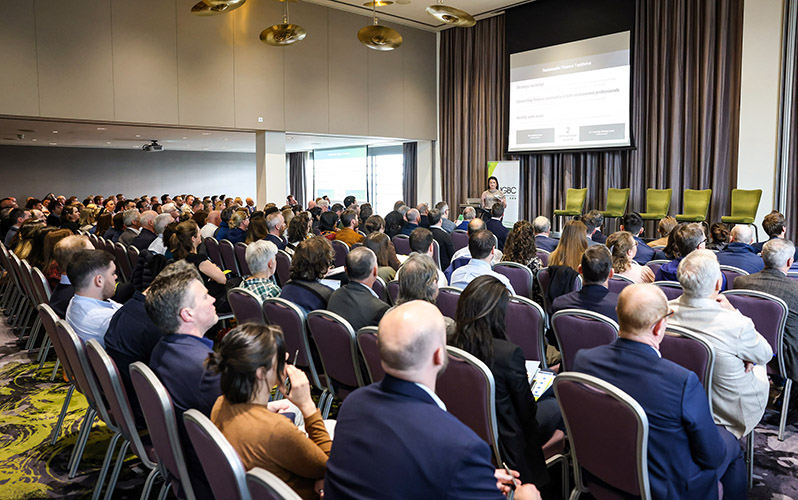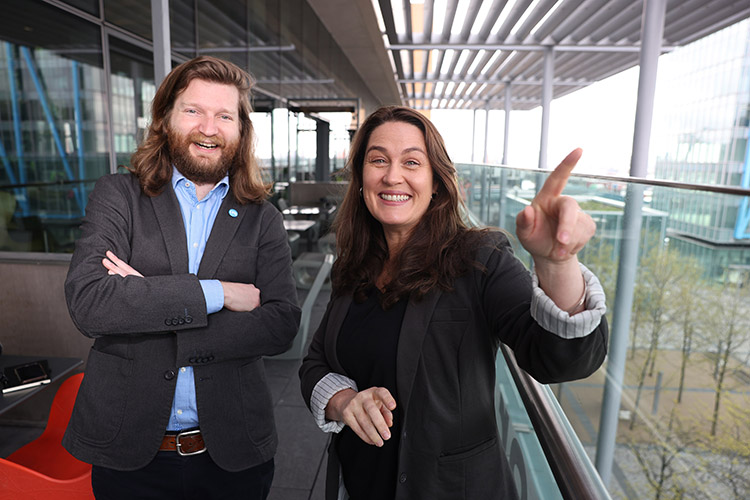On 12 May last, over 200 industry leaders gathered in Dublin for the Irish Green Building Council’s annual conference, ‘Build Green Now’.
Taking place six months after the launch of the Irish Green Building Council’s (IGBC’s) Building a Zero Carbon Ireland – A roadmap to decarbonise Ireland’s built environment, the conference discussed challenges and actions needed to accelerate the transition to net zero carbon buildings.
Opening the conference, Pat Barry, CEO, IGBC, called for immediate and more ambitious climate action in the industry. He said, “There are no excuses. Ireland’s greenhouse gas emissions are increasing again, everyone must act now. As a sector, we must advocate for a better use of our existing stock, but also design and construct buildings that not only have zero-carbon emissions, but also are constructed in more eco-friendly ways.”
Embodied carbon emissions, energy-efficient designs and circularity in construction, including effectively reusing construction materials and existing structures, were the key topics discussed at the conference.
Embodied Carbon Emissions – The Elephant In The Room
Although embodied carbon emissions from construction currently account for 14% of Ireland’s national emissions, they remain unregulated. Keynote speaker, Audrey Nugent, Director, World Green Building Council, explained that the proposed revision of the Energy Performance of Buildings Directive (EPBD) will address this issue, requiring measurement from 2027 onward. However, she stressed that “several European countries, including Denmark, France, and the Netherlands, have already addressed this issue, and that there was scope for member states to lead by example and support innovation, by moving faster than the EPBD requirements.”
Panellists highlighted the importance of measuring whole-life carbon to identify hotspots and reduce emissions.
Michael McCarthy of MMC Quantity Surveyors explained that 80% of the sustainability gains of a project, can typically be made in the first six weeks of a project design.
McCarthy explained, “Embodied carbon emissions can be reduced by up to 20% by changing materials at the end of the process, but far more savings can be achieved if we intervene early. This is also far more cost-effective.”
Joe Durkan, Head of Technical, National Retrofit, SEAI, said that the lack of data remains one of the biggest challenges to addressing embodied carbon emissions in Ireland, and encouraged everyone in the industry to submit case studies to the IGBC to support the development of a robust national methodology, saying, “Collecting standardised data is extremely important, and SEAI is proud to support the development of a national methodology to measure whole life carbon emissions as part of the Indicate project”.
Catriona Duggan, Director, Gottstein Architects, called for a full re-think of why we are building, and what we are building. She commented, “Better use of our existing stock and building less is where the priority should be if we are serious about addressing climate change. This must be better supported by legislation. We need carbon budgets at building level, and legislation that is fully aligned with our climate targets to support our architects in reducing our emissions.”
Designing For Performance – Measuring Actual Energy Use
During the second part of the conference, speakers discussed the importance of designing for performance (and not only for compliance) to achieve real carbon saving in the operational phase of a building life cycle.
William O’Donnell, Associate Director, IN2 Engineering, stressed that while Building Energy Ratings (BERs) are useful, they are only asset ratings, and need to be complemented by better quality data on actual energy performance. This was echoed by Neil Menzies, Director of Sustainability, Hibernia Real Estate Group, who explained that investors were increasingly looking for actual energy performance data to de-risk their operations.
To summarise, panellists called for better data on actual energy performance, and for more transparency in the market. To support this, the IGBC is encouraging building owners and investors to disclose operational energy use and actual carbon emissions of their office buildings as part of the Building Life II project.
Towards a circular built environment
The session on circular economy in construction started with an inspiring example of circularity in an eight-storey office block in Oslo, where Mad Arkitekter Norway maintained an existing structure and reused materials from other buildings. With a circularity material use rate of 2% in 2020 – versus 11% on average in the EU and 20% in the Netherlands, significant scope for progress exists in Ireland.
John Casey, Managing Director, CORA Engineering, explained that up 80% of the embodied emissions of a building are typically associated with the structure, hence a need to reuse our buildings more. Mentioning his work on the Treasury Building in Dublin, he stressed that reusing the steel in the extension was not only a way to save carbon emissions but also money.
John Casey explained, “Re-using steal is not only the right thing to do, it’s also the cheapest thing to do.”
However, all panellists agreed that selective demolition can take time and that this extra time needs to be built in to a project.
Philippa King, Regional Co-ordinator Environment, Southern Waste Region, subsequently talked about the Project Opera, part of Limerick 2030, and the challenges that exist around re-use in Ireland, covering issues around aggregates and end-of-waste, to the need for training and guidance documentation to better support re-use.
Next Steps
The Building a Zero Carbon Ireland roadmap includes a series of actions broken down by sector to accelerate Ireland’s transition to a fully decarbonise built environment. The IGBC encourages everyone in the industry to endorse the roadmap and take immediate action.
The IGBC provides support, including training, to support decarbonisation of the built environment, Learn more at: www.igbc.ie/building-a-zero-carbon-ireland/
ABOUT #BUILDINGLIFE
The Roadmap to decarbonise Ireland’s built environment will be launched on 07 October. It has been developed as part of the #BuildingLife campaign. The campaign aims to achieve the mix of private sector action and public policy necessary to tackle the whole-life environmental impact of buildings. The #BuildingLife campaign is funded by the IKEA and Laudes Foundations.
For further information on the Roadmap, the carbon modelling report commissioned to UCD, the Carbon Designer Tool or the EPD Ireland programme, visit www.igbc.ie/lca/





